Bass Fishing Docks | Fishing Docks For Bass
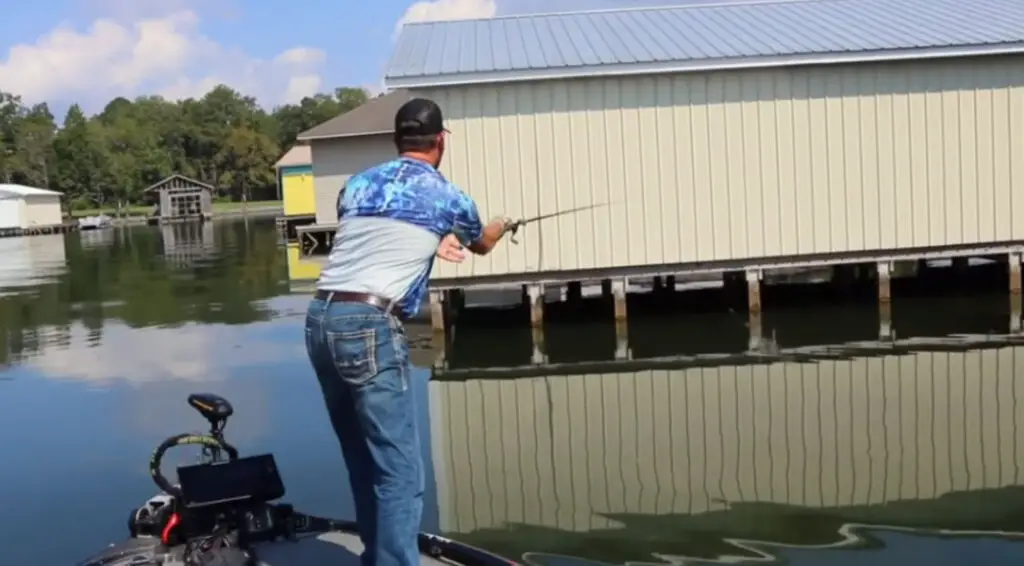
One thing is certain: not all docks or piers (as they are known in the South) are made equally.
Occasionally, if you visit many large lakes, you’ll see hundreds or even thousands of boat docks. And while it may be a surprise to some, there are several docks the fish seem to use frequently. In addition, most of the docks in the lake may have the occasional fish near them, while others may have no fish at all.
More often than not, you will encounter a row of docks so closely spaced that you will be at a loss as to which one to use fish first.
The key to bass fishing docks are: (1) looking for certain sorts of docks that have a greater likelihood to hold fish; (2) finding docks that are positioned in critical areas on the lake to lure fish in; (3) understanding what baits work best; and (4) knowing when to use each specific bait depending on the time of day, weather, and season.
Key Takeaways
Thankfully, dock fishing has become second nature to me now… but that wasn’t always the case. As I spent thousands of hours watching and learning from my mentors, practicing hundreds of hours on the lake… only to fail horribly…
However, over years of honing my skill whenever I had the chance, I slowly started to create my personal dock fishing blueprint, which is kinda-like my private set of strategies and tactics. Now whenever I get to the lake and see docks, I use my same blueprint and I can quickly pick out the best docks that are most likely to hold fish… which allows me to avoid wasting hours of my fishing day. Now my question to you… would you like to know more? Yes! Great, here are just some of the things you’ll learn in this dock fishing blueprint:
- Understand what dock types are more likely to hold fish… and… which to avoid as fast as humanly possible!
- How your PC can get you extra bites when you’re on the water!
- How you can legally check to see if the dock attracts bass… even if the dock looks like the hundreds of other docks in the area… you will get your answer in less than 1 minute… and helps you avoid spending countless hours on the wrong fishing spot!
- The single best way to fish a dock… this strategy will allow you to catch all the fish… never worry about spooking the rest… even if fish jumps off your hook!
- Learn the best one-two punch for making bass bite when your fishing docks – even Mike Tyson would be proud!
If you ever got suckered into fishing the wrong dock, you know it can be similar to being in a barren ghost town, wasting hours of your day, or forced to deal with a painful arm, or worse!
Our dock fishing blueprint helps you avoid all that… let’s get started…
But be warned! Go through this blueprint slowly and carefully so you don’t miss any tips that could cost you.
Dock Fishing Primer
If you already know why docks are important to fishermen just skip to the next section below, but if you don’t keep reading…
Dock fishing is one of the oldest types of bass fishing techniques, used by many generations of anglers to catch smallmouth, spotted, and largemouth bass.
Unfortunately, thousands of anglers have tried fishing docks, only to move to a completely different type of spot.
Why? Because fishing a dock the right way is a closely guarded secret.
The biggest reason to fish for bass is because you can hook into a lot of bass at docks. Not every dock will have bass, but the fish do like the man made wooden docks in most lakes.
Almost every manmade lake or reservoir has docks where anglers can moor their boats. The docks usually have ladders for swimmers and skiers to use.
Helpful Tip: Docks are beneficial to bass in several ways. They are a great place for bass to hide and wait to attack their prey as they swim by.
These structures also provide shade for bass. It is darker underneath a dock, and bass may get more active when they see your bait.
Dock fishing can be accomplished from the shore, kayak, float tube, or from your bass boat. Keep in mind that you may be able to reach more areas of the dock when fishing from your boat.
Step 1: What Are the Different Types of Docks and Why Are They Important?

Stationary docks are the most common kind of docks in lakes and reservoirs. These structures have legs that are attached to the lake bottom and support the dock.
Docks can be in many different sizes and shapes. A dock is usually made of wood in most lakes.
Some docks are made of metal, and anglers say that the bass do not like them. They base this on the fact that they seldom hold bass. If you find a metal dock, you may want to throw a few casts, and if you don’t get any bites, then move on to the next spot.
Floating docks are another type of docks that may be found in lakes. These docks are attached to the land so they will not float away.
The majority of professional anglers prefer fishing from floating docks because there is a lot of shade where the floats are laying on the water’s surface.
Lift-up docks are mainly used in lake housing communities that have cold winters. The lift-up dock stands up vertically so that snow and ice do not accumulate on it and cause damage.
Step 2: Finding Quality Docks at Home First
One of the best ways for anglers to find potential quality docks is with Google Maps. This website can show you a birds eye view of all the docks on your lake.
Here are what I consider the 3 prime dock locations for beginners to fish… please note… there are more locations to learn, but I don’t want you to be overwhelmed. With that being said, if you’re going to be bass fishing docks, these have a better than average chance of holding bass. And they’re going to be:
- (A) Docks that are located at the end of a row
- (B) Docks that are on a point
- (C) Docks that are all alone.
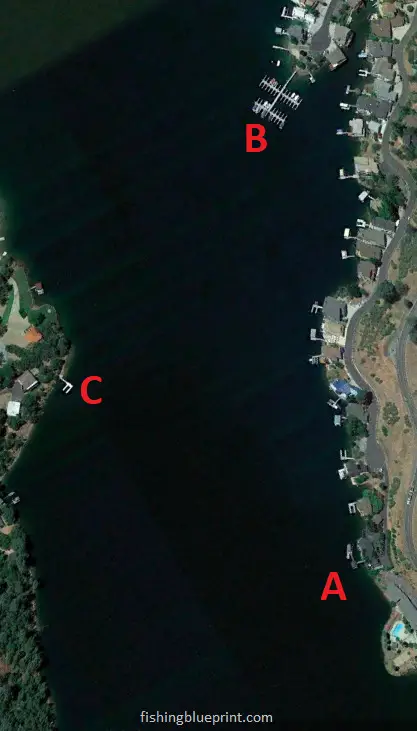
It’s really easy finding docks on Google Maps.
- Simply, pull up Google Maps and start looking at your favorite areas on the lake.
- Next, zoom in and verify it’s a dock not anything else (like a boat ramp, or a small pump station).
- Then find the prime dock locations that we previously discussed.
- As you find quality docks, save the GPS coordinates and plug it into your fish finder for you to use later.

In this example, Step 1 – Pull up Google Maps and start looking at your favorite areas on the lake.

Step 2 – Zoom in and verify it’s a dock not anything else (like a boat ramp, or a small pump station).
Step 3 – Find the prime dock locations that we previously discussed.
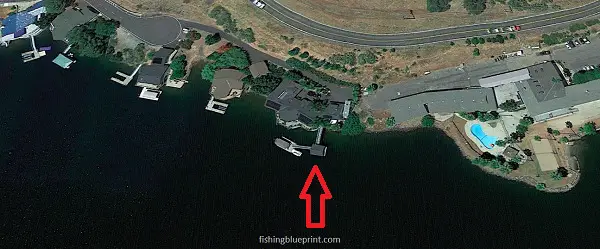
Here’s an helpful example of a dock at the end of a row.

Here’s a helpful example of a dock at the end of a point.
In the example above. I would fish the boat slips and the two docks on the end of the point.
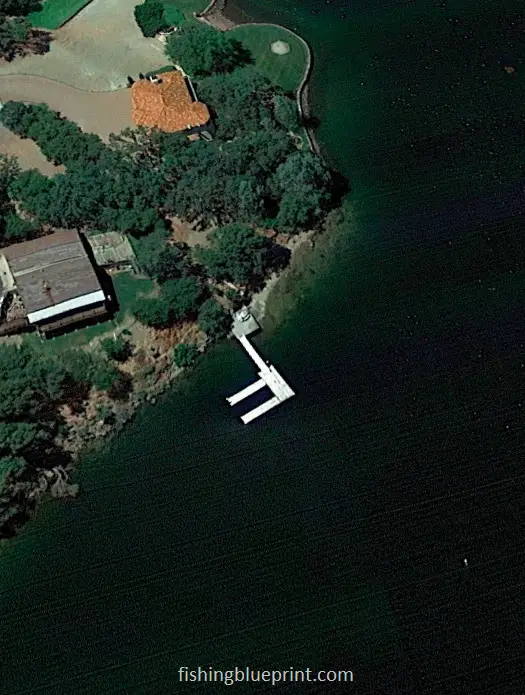
Here’s a helpful example of a dock that is alone.
But wait! Look closely… Can you spot the other structures that could also attract bass?…
There’s chunk rock the boarders each side of the lone dock…
There’s a vertical breakwall made for the owner’s landscaping (at the top of the picture)…
Lastly there’s also a laydown (at the bottom of the picture).
Bass will uses these secondary areas as hunting grounds during the morning and evenings, and at night… but during the day most (not all, but most… especially since that water is relatively clear) will seek shelter that that lone dock in the middle of the screen.
Step 3: Other Visual Indicators
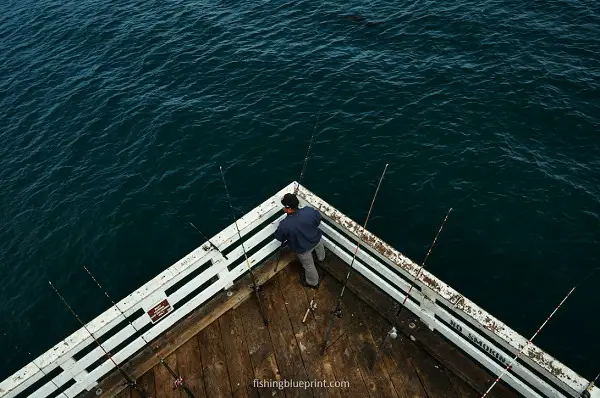
There are other ways to find out if a dock can be great for fishing, even if it doesn’t fall under what is considered a prime location for a dock.
One of the best ways I learned to spot one of these docks that could be a hidden gem is to find a dock that has a lot of fishing poles lined up on the rails…
This means the dock is more than likely used often for fishing. Which could also mean the owner of the dock potentially planted brush underneath the dock to attract bluegill, sunfish, and crappie… This in turn then will attract bass and catfish.
Step 4: Scanning for Brush Piles
So once you see a row of docks it’s incredibly smart to take your time to find out if any of these docks do have any brush piles that were dropped by the owner… and… the best and easiest way to do that is to use your fishing sonar.
The ability to customize your fish finder to display what’s on each side of your boat and how many feet you want the scan to cover on both sides makes side scans very useful.
Look for the shadow on the screen that indicates how far the brush pile is from the lake’s bottom. The distance between the brush pile and the lake bottom increases with the length of the shadow.
Because only bass are visible in these shadows, if you detect any little dots or lines, you may be sure that there are bass in the brush pile.
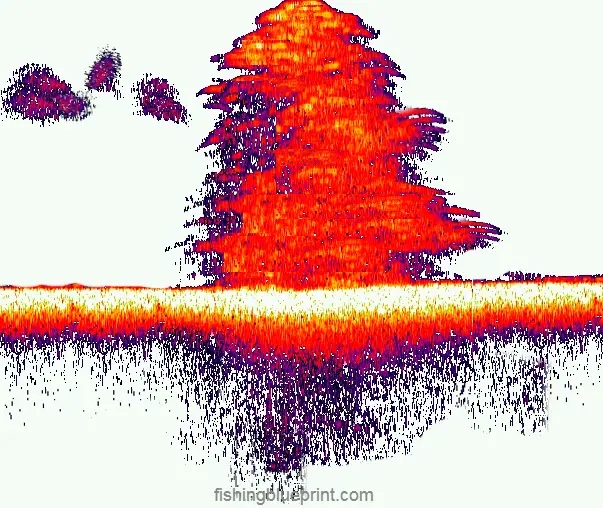
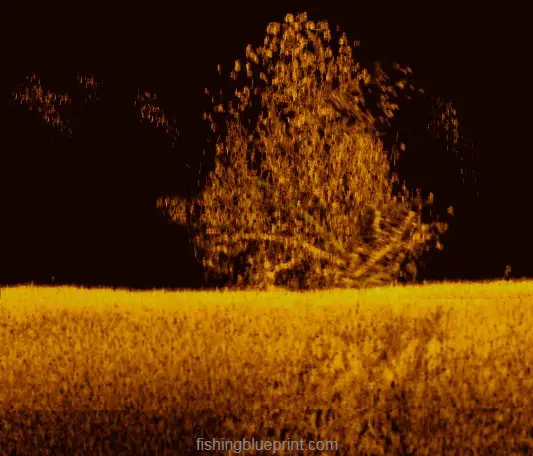
Step 5: Fishing The Dock Systematically
Experienced anglers say that the best strategy to fish a dock for bass is to fish the corners of the dock first. Bass often gathers near this spot.
Many other anglers say to fish the shallow side of the dock first. Work your way around the perimeter of the dock because bass are often on the edges of the dock, especially in the morning.
Regardless, we know that bass will pull up out of the deep water and go up shallow during different times of the day and season.
What’s cool about fishing a dock is you can actually fish it in five different ways.
Personally, I recommend a front to back approach.
- Start with the outside corners
- Second, fish the front
- Third, fish the sides
- Fourth, fish the back corners
- Fifth fish the deepest you can get your bait.
This is a tactic I learned from Strike King legend Denny Brauer. If you go for the deepest area you can first and lose the fish, the other fish around will get spooked and not bite.
Whereas, if you pick off the surrounding fish first, even if you miss a fish on the periphery, you still have a good chance to catch a fish the farther back you go.
Other tips when fishing a specific dock…
- Look for shade on the dock and focus here because bass love the cooler shade in the summertime. Another area that is often productive is in small shady areas along docks.
- Fishing bass between boats is another spot where you may get a bite.
- Lily pads and grass mats near the dock are other productive areas to catch a large bass.
- Underneath a dock is a prime spot. The best way to get your lure to the deepest darkest depths underneath the dock is skipping your lure underneath it.
- Other great places for bass fishing docks are near ladders on the dock and along the walkway. Sometimes bass move from one spot to another, so you may want to recheck some of the places where you cast earlier.
What are the Best Baits For Bass Fishing Docks?
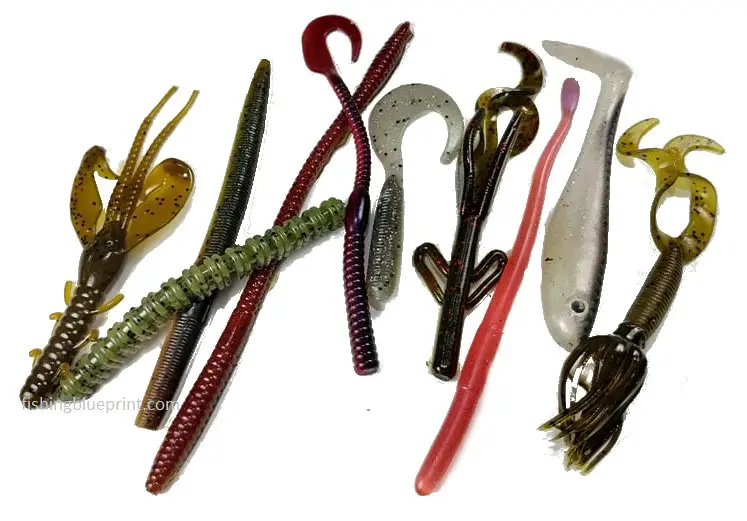
When choosing what bait you should you here’s a quick and easy list that helps me:
- Topwater lures, buzzbaits in the morning or on cloudy conditions.
- Crankbaits, spinnerbaits, jerkbaits, chatterbaits, umbrella rigs, underspin jigs, swim jigs, hair jigs, lipless crankbaits, and soft plastic swimbaits, perform well here in breezy conditions or during the midday.
- In contrast, slower moving baits such as drop shot, football jigs, tubes, wacky rig, Texas rig, Neko rigs, and Carolina rigs can be phenomenal when the conditions are calm or the bass are holding close to the rocks.
- Flutter spoons work great in the deepest part of the dock or over any secondary structures directly related to the dock.
My Personal Notes: My 2 Biggest Problems with Fishing a Dock
One big problem I had when I was first getting started was my flipping skills and skipping skills were absolutely horrible to reach deep areas under a dock.
But what I’m about to say next may surprise you… If you’re just getting into dock fishing, don’t worry about skipping your lures yet.
I feel it’s more important to learn to flip your lures correctly, more than anything else.
As you get the feel and experience of breaking down the lake, choosing the right dock first, and then knowing how to approach and fish the dock systematically like a surgeon is the best advise I can give you…
As you get better and better, start with skipping something that is really forgiving, like a Senko on a spinning rod… then… as your skill continues to improve, move on to other baits.
If you practice flip casting first, you will avoid the frustration of putting your lure in the wrong location, getting hung up on dock cables, and hitting the dock and spooking the fish.
Helpful Tip: It takes practice to be able to flip into small bare areas on the dock. Only the best flippers can reach deep into the back where the large bass generally sit.
Another huge problem I had was I lacked patience. Fishing docks for bass can be slow moving… and to make matters worse, I have ADD! YIKES!!!
But that is why I developed a systematic list to tactically pick apart the dock to try to catch all the fish.
Remember, you’re not alone in your frustration… you may fish several docks before making a catch, or you may not make any catches at all.
Bass fishing docks also requires a stealth approach. Position your boat as far away from the dock as possible, turn off the radio, and stay quiet.
The discipline you need to fish docks will pay off when you find a spot in the channel where you catch a hog. Bass are caught year-round at docks.
Want To Learn Where To Catch More Bass? Checkout These Articles...
- Bass Fishing CREEKS The Easy Way (In Less Than 10 Minutes)
- Warning: Bass Fishing HEAVY GRASS? [15+ Mistakes To Avoid]
- Bass Fishing POINTS in 5 Quick & EASY Steps!
- Complete 5-Step DOCK Fishing Formula
- Bass Fishing LAYDOWNS [Complete Guide + Pictures]
- Little Known Pattern for Fishing TREES for Bass.. Now and Forever
- Complete Formula For BASS FISHING ROCKY BANKS & RIPRAP
- The 5 TRUTHS about Bass Fishing BRIDGES and Avoid Wasting Time On Techniques That Don’t Work!
- Bass Fishing BRUSH PILES To Catch The Most Bass In Minimum Time!
- The 7-step Secret Formula for Bass Fishing LEDGES – Even a Complete Fishing Noob Can Use and Be 100 Times More Potent Than the Best B.A.S.S. Professional!
- The Single Best Guide to Fishing SHELL BEDS… and… Do It Fast!
- 5 Basic Elements Of Fishing HUMPS AND RIDGES No One is Talking About!
- 5 Crucial (and Unusual) Tactics You Must Do When Bass Fishing ROADBEDS!
- Top 25 Summer BANK Fishing Tips (Never Get Skunked Again)
- [EXPERT REVEALS] Bass Fishing In MUDDY WATER Secrets – 27 Tips & Mistakes To Avoid Today!
- 31 Best Tips for Bass Fishing At NIGHT (Complete Guide)
Checkout These Other Summer Fishing Articles...
- Complete 5-Step Formula For BASS FISHING DOCKS
- The 7-step Secret Formula for BASS FISHING LEDGES – Even a Complete Fishing Noob Can Use and Be 100 Times More Potent Than the Best B.A.S.S. Professional!
- Top 25 Summer Bank Fishing Tips (Never Get Skunked Again)
- Bass Fishing In Heavy Grass? [17+ Mistakes To Avoid]
- 7 Top Secret Weedless Bass Lures for Flipping into Heavy Grass -Exposed!
- How To Fish A Crankbait [TOP 10 Essential Secrets To Catching Bass With A Crankbait]
- 15 Best Deep Diving Crankbaits [2023 Buyers Guide – Which to Buy & Avoid]
- Fish a Flutter Spoon The RIGHT way... like the Pros... And Do It TODAY!
- NEW and truly "no brainer" (yet usually overlooked) way to MASTER SOFT PLASTIC PADDLE TAIL SWIMBAITS and increase the amount of bass you catch 100% or more... automatically!
- Top 5 questions and challenges every about hair jig fishing... AND how to overcome common problems most anglers encounter (and then prematurely quit).
- Top 10 Best Jigs For Bass Fishing [Insiders Only]
- Avoid this ONE Texas rig fishing NIGHTMARE - And increase your Texas rig fishing expertise FAST!
- 31 Best Tips for Bass Fishing At NIGHT (Complete Guide)
- 2023 Buyers Guide Best GREEN FISHING LIGHT [LED FISHING LIGHTS Reviews & Tips]
- Dock Lights For Night Fishing [Best Products, Secrets, & Tips]
Other Bass Fishing Articles Just For You...
Selecting Early Summer Bass Fishing Lures [Avoid 5 Common Mistakes]
A Complete Buyer’s Blueprint On The Best Early Summer Bass Lures On The Market Today! When it comes to bass fishing, choosing the right lure
Early Summer Bass Fishing [Avoid These 3 Sneaky Lies]
Learn these closely guarded secrets early summer bass fishing … and… dramatically boost your advantage over other anglers! Late spring to early summer bass fishing
Fear The Finesse? 7 Ned Rig Fishing Secrets Exposed!
Conquer the Fear of Finesse… and… Unlock the Potential Ned Rig Fishing – TODAY! Fellow Angler… Like most of you I’m pretty set in my
Fishing Spawning Bass [18+ Lures & Gear]
Get Ready For The Spawn Now When bed fishing, stealth is of the biggest essential tip. Instead of racing forward with a trolling motor, anglers
[2024 Editors Choice] Picking The Best Bass Fishing LINE For ANY Budget
What is the best bass fishing line? | What is a good fishing line for bass? The best type of bass fishing line is based
Drift Sock Basics – What It Is A Drift Sock & How To Use It [2024 Quick Start Guide]
What Does A Drift Sock Do? | Why Use A Drift Sock? photo cred: WLUK We’ve ALL been there… you work your butt off the

